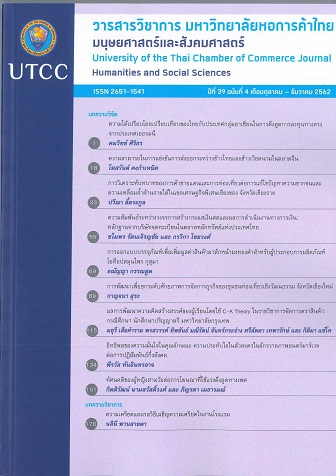Packaging Design to increase the value for Gold Face Mask product of Kusuma : OTOP Herbal Product Manufacturer, Bangkok, Thailand
Main Article Content
Abstract
While OTOP products have received more interest from domestic consumers. Many operators still neglect to add value with packaging design. This research is therefore designed to study the packaging as a means to add value to their products. The study focuses on expert opinion and consumer satisfaction surveys. In order to analyze the dimension of adding value by packaging design, statistics, average satisfaction ( ) and standard deviation (SD) are used in data analysis.
The statistical test results indicate that the target group has a high level of satisfaction in all aspects. That means all 6 variables can be used as a design criteria to add value to the product ranking from the most to the least as follows; Functional benefits, Aesthetic, Material value, Price, Confidence in the product, Originality. Moreover the "Total Value Added" variable, which is caused by the sum of all 6 variables, has a high level of average satisfaction. So it may be pointed out that it also can be used as a design criteria to add value.
Article Details
ลิขสิทธิ์ของบทความ
ผลงานที่ได้รับการตีพิมพ์ถือเป็นลิขสิทธิ์ของมหาวิทยาลัยหอการค้าไทย ห้ามมิให้นำเนื้อหา ทัศนะ หรือข้อคิดเห็นใด ๆ ของผลงานไปทำซ้ำ ดัดแปลง หรือเผยแพร่ ไม่ว่าทั้งหมดหรือบางส่วนโดยไม่ได้รับอนุญาตเป็นลายลักษณ์อักษรจากมหาวิทยาลัยหอการค้าไทยก่อน
References
ดำรงศักดิ์ ชัยสนิท. (2537). การบรรจุภัณฑ์. กรุงเทพฯ: วังอักษร.
ตระกูลพันธ์ พัชรเมธา. (2559). ผลิตภัณฑ์หัตถกรรมกับการพัฒนาสู่สินค้าหนึ่งตำบลหนึ่งผลิตภัณฑ์. วารสารมหาวิทยาลัยศิลปากร, 36(1), 67-80.
ธิดารัตน์ เอี่ยมศิริรักษ์. (2548). การสื่อสารการตลาดที่มีผลต่อการเลือกซื้อสบู่สมุนไพรชนิดก้อน ของผู้บริโภคในอำเภอเมือง จังหวัดเชียงใหม่ (วิทยานิพนธ์ปริญญามหาบัณฑิต ไม่ได้ตีพิมพ์). มหาวิทยาลัยเชียงใหม่.
นิภาภรณ์ จงวุฒิเวศย์. (2550). ทิศทางการส่งเสริมผลิตภัณฑ์ ชุมชนและท้องถิ่น. สืบค้นเมื่อ 18 มกราคม 2562, จาก https://www.cep.go.th/cep_web/kbo/OTOP50_ 16%20Nov%202006.ppt#270,13
บุษรา สร้อยระย้า, ชมภูนุช เผื่อนพิภพ, ดวงกมล ตั้งสถิตพร, อัชชา ศิริพันธุ์, และประพาฬภรณ์ ธีรมงคล.(2556). การพัฒนาบรรจุภัณฑ์เพื่อสิ่งแวดล้อมจากเส้นใยกล้วยสำหรับบรรจุผลิตภันฑ์อาหารสำเร็จรูป. วารสารวิชาการและวิจัย มทร. พระนคร, 7(1), 9-24.
พีรวงศ์ จาตุรงคกุล. (2560). การพัฒนาสินค้าเพื่อเข้าสู่ตลาดออนไลน์. สืบค้นเมื่อ 18 มกราคม 2562, จาก https://www.smego.rmutt.ac.th/download/Sukhothai/Presentation-1_Sukhothai.pdf
ยอดเยี่ยม เทพธรานนท์. (2551). อะไรกันแน่คืออุปสรรคในการ “เพิ่มคุณค่าสินค้าด้วยการออกแบบ” ของเมืองไทย. สืบค้นเมื่อ 23 เมษายน 2562, จาก www.tcdcconnect.com
วัชรินทร์ จรุงจิตสุนทร. (2548). หลักการและแนวคิดการออกแบบผลิตภัณฑ์. กรุงเทพฯ: แอ๊ปป้า พริ้นติ้ง กรุ๊ป.
วารุณี สุนทรเจริญนนท์. (2557). สร้างผลิตภัณฑ์หรือบริการสร้างสรรค์ไม่ยากอย่างที่คิด. สืบค้นเมื่อ 16 มิถุนายน 2560. จากhttps://www.amexteam.com/resources/helper/editor/upload/knowledge/1/01_.pdf
สักขี แสนสุภา. (2545). การออกแบบบรรจุภัณฑ์กลยุทธ์การเพิ่มมูลค่าสินค้า. อุตสาหกรรมสารวารสารการบรรจุภัณฑ์. กรุงเทพฯ: ส่งเสริมอุตสาหกรรม.
สุทธิศักด์ กลิ่นแก้วณรงค์. (2558). การออกแบบบรรจุภัณฑ์ เพื่อผลักดันผลิตภัณฑ์ OTOP. วารสารกรมวิทยาศาสตร์บริการ, 63(199), 19-21.
สุมาลี กรดกางกั้น. (2558). การออกแบบและพัฒนารูปแบบบรรจุภัณฑ์ทุเรียนอบกรอบในอำเภอเจาะไอร้อง จังหวัดนราธิวาส. วารสารมหาวิทยาลัยนราธิวาสราชนครินทร์, 7(2), 147-156.
องอาจ นัยพัฒน์. (2551). วิธีวิทยาการวิจัยเชิงปริมาณและเชิงคุณภาพทางพฤติกรรมศาสตร์และสังคมศาสตร์. กรุงเทพฯ: สามลดา.
อัจฉรา วิเศษศรี. (2560, 20 พฤษภาคม). สสว. ดันผลิตภัณฑ์ท้องถิ่นให้ผู้ประกอบการ SMEs พัฒนาผลิตภัณฑ์และบรรจุภัณฑ์ให้มีคุณค่าและเพิ่มมูลค่าพร้อมเปิดตลาดการค้าทั้งในและต่างประเทศ. TNews. สืบค้นจาก https://www.tnews.co.th/region/453737/
เอกจิตต์ จึงเจริญ. (2553). "กลยุทธ์การออกแบบ" สู่ความสำเร็จของธุรกิจยุคใหม่. วารสารบริหารธุรกิจ, 33(128), 7-13.
Agariya, A. K., Johari, A., Sharma, H. K., Chandraul, U., & Singh, D. (2012). The role of packaging in brand communication. International Journal of Scientific & Engineering Research, 3(2), 1-13.
Argandona, A. (2011). Stakeholder theory and value creation. Retrieved from https://media.iese.edu/research/pdfs/DI-0922-E.pdf
Azzi, A., Battini, D., Persona, A., & Sgarbossa, F. (2012). Packaging design: General framework and research agenda. Packaging Technology and Science, 25(8), 435-456.
Dobson, P., & Yadav, A. (2012). Packaging in a market economy: The economic and commercial role of packaging communication. Retrieved from https://www.packagingfedn.co.uk/images/reports/Packaging%20in%20a%20Market%20Economy.pdf
Favier, M., Celhay, F., & Pantin-Sohier, G. (2019). Is less more or a bore? Package design simplicity and brand perception: An application to champagne. Journal of Retailing and Consumer Services, 46, 11-20. doi:10.1016/j.jretconser.2018.09.013
Hamlin, R. P. (2016). The consumer testing of food package graphic design. British Food Journal, 118(2), 379-395. doi:10.1108/bfj-03-2015-0105
Kotler, P. (2000). Marketing management (millennium ed.) Upper Saddle River, NJ: Prentice-Hall.
Kotler, P., & Keller, K. L. (2006). Marketing management (12th ed.). Upper Saddle River, NJ: Pearson Prentice Hall.
Krishna, A., Cian, L., & Aydınoğlu, N. Z. (2017). Sensory aspects of package design. Journal of Retailing, 93(1), 43-54. doi:10.1016/j.jretai.2016.12.002
Likert, R. (1967). The method of constructing and attitude scale. In M. Fishbeic (Ed.), Attitude theory and measurement (pp. 90-95). New York, NY: Wiley.
Nancarrow, C., Wright, L., & Brace, I. (1998). Gaining competitive advantage from packaging and labelling in marketing communications. British Food Journal, 100(2), 110-118.
Orth, U. R., & Malkewitz, K. (2008). Holistic package design and consumer brand impressions. Journal of Marketing, 72(3), 64-81.
Ritnamkam, S., & Sahachaisaeree, N. (2012). Package design determining young purchasers ‘buying decision: A cosmetic packaging case study on gender distinction. Procedia - Social and Behavioral Sciences, 38, 373-379. doi:10.1016/j.sbspro.2012.03.359
Rundh, B. (2005). The multi-faceted dimension of packaging: Marketing logistic or marketing tool? British Food Journal, 107(9), 670-684.
Rundh, B. (2016). The role of packaging within marketing and value creation. British Food Journal, 118(10), 2491-2511. Retrieved from https://doi.org/10.1108/BFJ-10-2015-0390
Schifferstein, H. N. J., Fenko, A., Desmet, P. M. A., Labbe, D., & Martin, N. (2013). Influence of package design on the dynamics of multisensory and emotional food experience. Food Quality and Preference, 27(1), 18-25. doi:10.1016/j.foodqual.2012.06.003
Schoormans, J. P. L., & Robben, H. S. J. (1997). The effect of new package design on product attention, categorization and evaluation. Journal of Economic Psychology, 18(2-3), 271-287.
Shan, Y. (2018). Modern design and cognitive neuroscience: Impact of cognitive theory on green package design. NeuroQuantology, 16(6), 366-370. doi:10.14704/nq.2018.16.6.1591
Smith, J. B., & Colgate, M. (2007). Customer value creation: A practical framework. Journal of Marketing Theory and Practice, 15(1), 7-23.
Utkarsha S., Shivsharan, R. E. S., & Shaikh Z.M. (2014). Packaging of cosmetics: A review. Journal of Pharmaceutical and Scientific Innovation, 3(4), 287-293.


